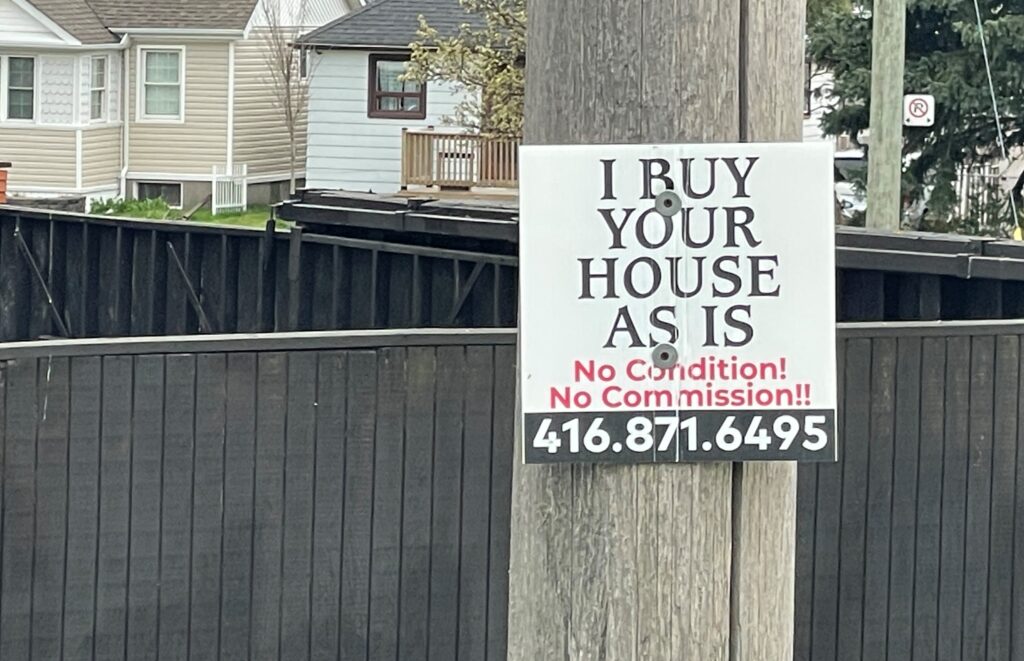Would you buy a house if you didn’t know how many bedrooms it had?
Probably not.
So why do we see condominium listings without any indication of how many square feet the unit is?
I’ve been pushing this issue at the TREB level for quite some time, and it looks like we’re making progress…

When filling out the “MLS Data Sheet” for new listings; be it condominiums or houses, you’re shown which fields are “mandatory” and which fields are not by the colour-coding of the category.
Surprisingly, there are only a half-dozen categories that are not mandatory, and two of these are among the most important in my mind: square footage and age.
For example, “Basement” is a mandatory category, which is absolutely ridiculous, considering I’ve never seen a condominium with a basement.
“Fireplace/Stove” is also mandatory, as is “Family Room.” We’re talking condos here, not houses!
So then why aren’t “Square Footage” and “Age of Building” mandatory?
That’s a question I first asked two years ago at the Condominium Task Force’s introductory meeting.
We were all asked to propose ideas or perhaps to complain to eachother about things we’d like to change, and I gave the group the very example I posed above – about the notion of buying a house without knowing how many bedrooms as it can be compared to buying a condo without knowing the square footage.
So much of what we do in the condo market is based on square footage, whether is has to do with pricing the condo itself or recommending the unit to our clients.
It boggles my mind how we have continued to conduct business in this industry without ever having made the “square footage” requirement a necessary aspect of MLS listings.
There’s nothing I hate more than going on to MLS and seeing this:
There is NOTHING written in the “Apx Sqft” field.
Nothing!
I think this is lazy and unprofessional on the part of any Realtor who lists a property for sale, but then again, if we wanted to talk about lazy and unprofessional, we could just look at the fact that there are no room measurements or descriptions either. I digress…
The major issue with making the square footage field mandatory has to do with accountability, which of course could lead to significant legal disputes.
If a seller and an agent listed the square footage as “575” on the MLS listing, and the square footage turned out to be 550, then it could lead to a serious legal problem.
This of course leads into an even more detailed discussion about how to correctly determine square footage, but that’s another story.
Once upon a time, I proposed that we make the square footage field mandatory, and we make it an exact amount! The seller of a condo and the Realtor for that seller should be able to determine through various sources exactly what the square footage is!
But this idea was voted down, and for good reason, as I soon found out.
Before we ever considered implementing this idea, there was much work to be done.
So in the meantime, we moved to shrink the categories from “500-699” and “700-1100” down to individual categories of 100 square feet. That would at least give the buyer or MLS-browser a better idea of the actual square footage. After all, isn’t “700-1100” a ridiculous category? You’re talking about a $350,000 condo versus a $550,000 condo right there!
I think that shrinking the categories is a good start, but what does it accomplish if the categories themselves aren’t mandatory?
So again, we come back to the issue of how to correctly determine square footage, as we could be opening up an enormous legal can of worms.
The most common way to determine square footage is to provide the original builder’s plans from when the condo was being constructed. As well all know, every element of a pre-construction condo is “subject to change with no notice,” so the builder’s plan may not be correct. However, I think this is probably the most common method, as seen from this MLS excerpt below:
This could either be viewed as a potential attempt to lay fault with the builder in the event that the square footage quoted isn’t deemed accurate, or it could be viewed as a source for the measurement and it can be taken approximately.
Most MLS listings will say “approximately” anyways.
Personally, I think if we’re going to quote a square footage on MLS, approximate or not, we should provide a source.
This was brought up at our last Condominium Task Force meeting, as we want to avoid opening the door to lawsuits by trying to determine which sources are reputable and which aren’t.
For example, you can’t just say “715 square feet as per seller’s best guess.” That’s not helping anybody.
But you could have a list of ‘authorized’ sources that sellers and/or Realtors can work with.
MPAC provides property assessment values but they do much more than that! There are dozens of tools on their website, including the square footage of any condominium unit in the city. For a nominal fee of $5.00, the user can find out the square footage, although we still don’t know MPAC’s source! Sidebar: I wish we could force Realtors to spend the measly $5.00 to help make MLS more useful and informative, but that would be too much to ask…
PlanIt is another option, and a great one at that. They’re used more commonly for houses than condos, but for a modest fee (a few hundred dollars) you can have your entire condo mapped out and measured within a hair. I assure you – they’re more than just a guy with a measuring tape! They use state-of-the-art engineering software and laser measuring to produce a floor plan and an accurate account of square footage.
The status certificate can be another source of the illusive square footage measurement, although not every status certificate has the exact square footage quoted. I find that if the development is new and the developer/builder also has a property management company who is actively managing that building, then you’ll more than likely have access to the correct square footage.
All of these options would be reasonable to quote as a source for the square footage on the MLS listing.
And in my humble opinion, I think Realtors should spend an hour Googling the building to try and find floor plans, wherever they may be hiding. If I had a listing in a building of less than three years in age, I can almost guarantee you I could find the corresponding floor plan somewhere on the Internet.
But I understand how TREB can be weary of “forcing” the issue since we don’t really have a definition of how to measure square footage. Even developers themselves measure it differently!
If you look at the real estate boards across Canada, you’ll see that some boards have the field as mandatory, and some don’t.
But I sometimes feel embarrassed when I bring a client to a condo and they ask, “How many square feet is this?” As I’m forced to answer, “Ummm……I think it’s about…..maybe 670 to 690……ish….”
Baby steps.
First, we’ll shrink the fields from 500-699 and 700-1100 to increments of 100 and hopefully that will help buyers as they browse on MLS.
Then, we’ll make the field itself mandatory, so that you can no longer list a property without even giving a range!
Eventually, I’d love to hammer out a list of acceptable sources so that we can encourage listing agents to find the square footage and detail it on the listing.
“As Per Builder Plan”
“As Per MPAC”
“As Per Status Certificate”
Wow, do I ever love the sound of that!
Yes, we’re making the world a better place, one step at a time…































Colin
at 9:42 am
David,
Why is square footage never really discussed with houses?
moonbeam!
at 10:31 am
Hmm.. whoever said size doesn’t matter…. couldn’t be talking about real estate!
JG
at 11:46 am
little off topic –
Happy Hallowe’en!!
Time to bring out the sexy cop outfits!! LOL!!
Gotta love the one day of the year its accepted to dress in underwear at a club and call it a Costume!
hmm..guess this was really off topic!
FrankyB
at 11:54 am
How about the classic ___ square feet of indoor and outdoor space. I like outdoor space as much as you do David (well, maybe not quite as much), but not to the point where outdoor space is considered fungible for indoor space!
Doug
at 2:19 pm
Embarassed, you should be! for any agent to not know the EXACT square footage of a condo is tantamount to not knowing how many seats are in a car that a dealership is selling. I understand it’s not your fault but how has this been able to continue?
Home Mortgage Loan
at 5:07 am
I agree with Colin that Square footage should be discussed with the the Houses.
Home Mortgage Loan
IanC
at 7:21 am
How much does PlanIt cost? I know builder’s plans vs the final result is off – just look at mls photos of living rooms and kitchens, and the plans – and see where they don’t match. Lower floors can also be smaller inside (but measured from outside and between walls it’s the same).
With the high price of condos per square foot, and their high maintanence fees, shouldn’t we know both square footages? The usable vs. non-usable? Or have it broken down?
715 square feet builders plan (to outside wall and halfway on shared walls)
680 actual square feet (to outside wall and halfway on shared walls) – still within 5% of builder’s plan
So you have 680 square feet. Count the balcony separate, but show what the 680 square feet is made up of:
530 floor space
40 floor space – closets
20 ducts
30 interior walls, pillars, and dead space
60 exterior and shared walls
I know that hard numbers are probably less of a factor than the perception of space – affected by layout, light, and individual preferences on how they want to use their space.
But this could be very useful. You could realize, that buying a corner unit in a hard loft, with one exposure walled in and the front exposure glassed – you could be paying months and years of high maintance on space that you can’t use – while your neighbour spends several thousands less over the years and gets more interior floor space.
David Fleming
at 12:19 pm
@ Colin
Square footage for houses is commonly detailed in new developments and subdivisions. Reason being – everything is the same age, has the same finishes, and is in the same area. You can compare across the board.
With houses in Toronto today, every area is so different, and a block east or west can make a huge difference in the value of the property. Houses are all different ages, with different renovation periods, and since they are generally much larger than condos, the variance is greater. It’s so hard to make comparisons based on square footage.
Having said that, I think it would be extremely helpful to have a square footage listed on MLS for all houses! More information can’t exactly hurt!
But as I said in my article above, many sellers and agents worry about the legal ramifications of listing incorrect measurements. Inserting a note on the MLS listing that says “Buyer to verify all measurements” has been repeadedly shot down in the courts. It’s not worth the paper it’s printed on. Unless a seller (or the agent) are willing to pay to have PlanIt come in and map the entire household, I might be weary of listing square footage. Of course, that’s why we have the glorious word “approximately.”
John
at 6:22 pm
I can see when square footage is not given in a listing, it could be frustrating for a Buyer.
Being a Real Estate agent, we need to be careful when indicating this measurement as well as other particulars.
Legalities has given us the options. It’s difficult to see the true specifications of a home. You need to see a home for yourself to get the true feeling of the size. Homes that have a open concept layout may seem bigger but with this layout, size may not be that transparent.
Paul Meredith, CityCan Financial
at 2:35 pm
As a mortgage broker, I have always been fascinated by this myself. Age and square footage ARE required fields for CMHC insured mortgage application submissions. It makes it quite frustrating when we have to go on an Easter egg hunt to find something that should be there in the first place. I am surprised more home buyers don’t complain about this actually. More so for condo buyers.